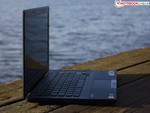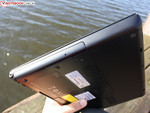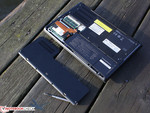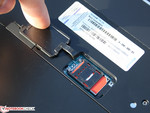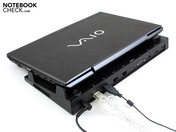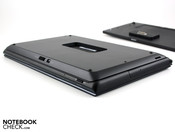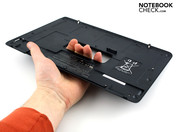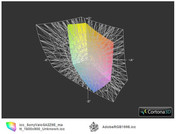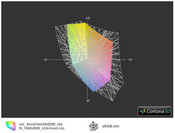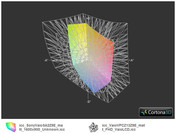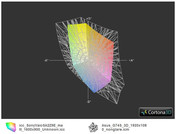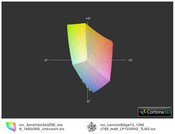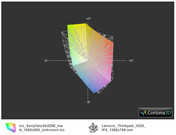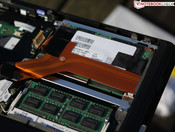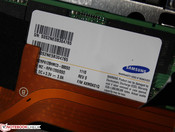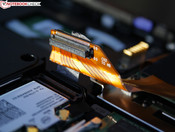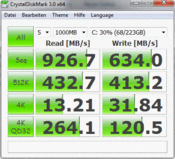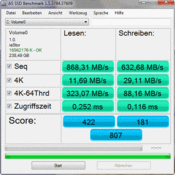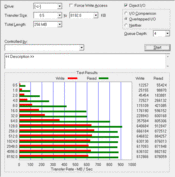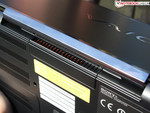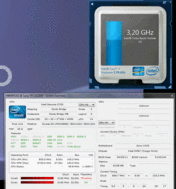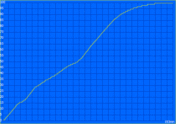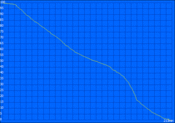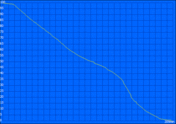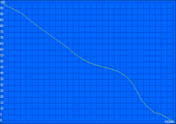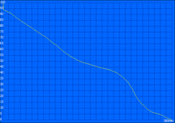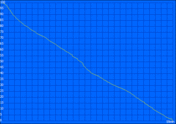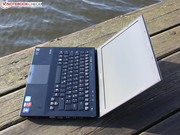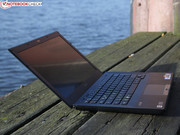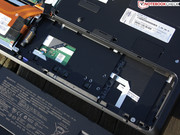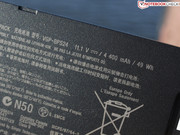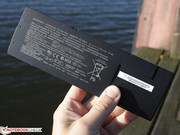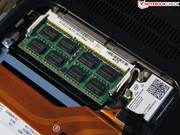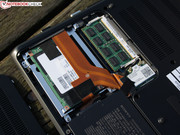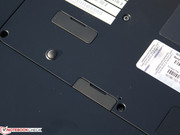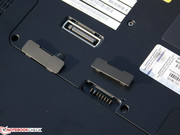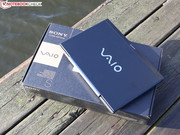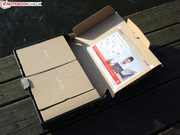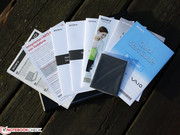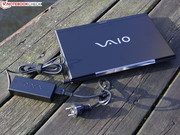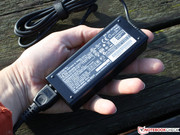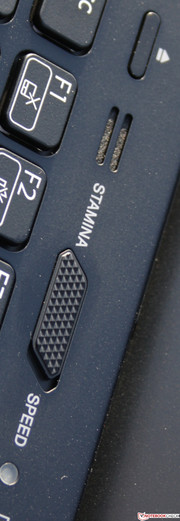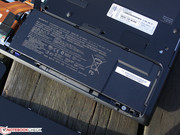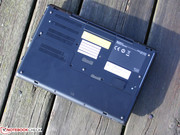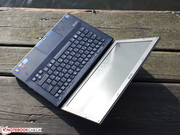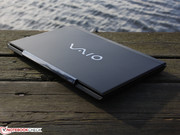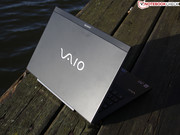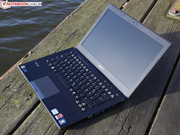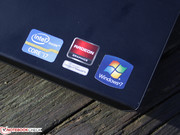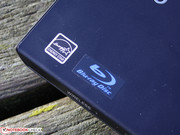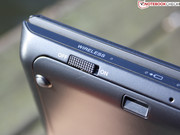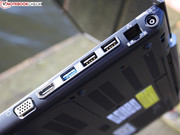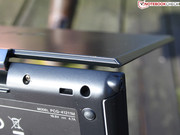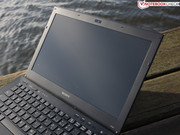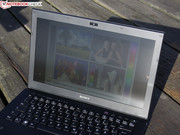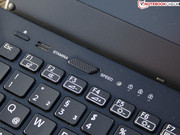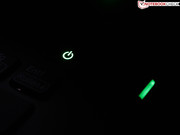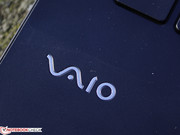Review Sony Vaio VPC-SA2Z9E/B (i7, SSD, HD 6630M) Subnotebook

The SB and SA models belong to Sony's Vaio S range. While SBs are positioned as affordable business all-rounders, the equally built SA is to cover the high priced sector. Almost 2400 euros is a lot of money for a 13 incher. But, the luxury-savvy customer is offered a lot - at least on paper.
Core i7 Dual Core, Radeon HD 6630M with de-activatable graphics, a 256 GB SSD in RAID0 and a matt WXGA++ screen. It is debatable if the price for this handy powerhouse is justified. However, it can't be denied that it is a very interesting test device due to the awesome combination of highest performance and portability. Our comprehensive review will reveal all information about the luxury 13.3 incher.
Case
Sony's 13.3 incher weighs 1652 grams and the 90 watt power adapter adds 286 grams. The case has a good torsional stiffness for mobile usages. The smooth wrist-rest convinces with a high stiffness and can't be dented even a bit anywhere. The work surface's matt and to the largest extent fingerprint resistant surface is very suitable for working on the go. Sony hasn't used any kind of glossy surfaces.
A clattering battery was a typical Sony characteristic for a long time. This is no longer the case because it can be found underneath a cover on the bottom. It's tightly locked there, but it can be removed.
The surfaces above the keys and the base plate fit tight and don't yield anywhere - not even over the optical drive (only marginally below). The aluminum magnesium alloy, which makes up the case, has a positive impact here. The material is stiff and looks high-end due to the hard, metallic cool surface (painted).
The matt lid is acceptably rigid in view of its flat design. We can twist the display by a few degrees when held at the corners. Nevertheless, light pressure on the lid's surface doesn't cause denting. The hinge has a firm grip on the lid, but it has a peculiarity. As of an 80 degree opening, the needed force lessens for the distance of about 20 degrees just to bid the known grip at 100 degrees again. This behavior, mechanically induced in the hinge, lets the lid open to the usually desired 130 degrees almost "by itself".
The lid's teetering that we reproached in the equally built SB range (German) hasn't completely, yet almost ceased. The lid's stop at the maximum opening is now also firmer than in the SB test device.
Connectivity
Almost all interfaces are located on the case's right. While front and rear don't supply any ports, we only find the headphone jack on the left. Three USB ports (among them 1 USB 3.0), VGA, HDMI and Ethernet are gathered on the right. The dual card reader (Memory Stick, SD) is standard on all Vaio notebooks. The port positioning allows a good cable routing to the right rear. The desk's left is spared from a cable mess.
Communication
Wireless communication is up to date: Gigabit LAN, draft n WLAN, Bluetooth and a Qualcomm Gobi HSDPA module for mobile Internet access. The SIM card for the latter is inserted into the base plate underneath a hard rubber cap.
Security
The hardware security features don't go beyond a Kensington lock, a fingerprint reader and the shock-proof SSD.
Supplies
The SB models' docking solution, VGP-PRS20 (about 129 euros) also fits on our SA device. Please see our detailed review of the docking station and battery slice. In addition to HDMI, VGA and 2 RJ45s (LAN), it supplies four USB ports. The HDMI, VGA & RJ45 on the laptop can no longer be used when the 13 incher is on the station. The battery slice, VGP-BPSC24 (lithium polymer), costs 130 euros and is clicked on underneath the chassis.
Warranty
The manufacturer's warranty is 24 months. The customer, however, only receives this period at registration subsequent to purchase. An according warranty extension (plus one year) is adhered to the box. If you'd like onsite repair, you can buy the service pack, VGPE-VPPSL/3, valid for three years (270 euros).
Input Devices
Keyboard
The single keys have a clear gap (four millimeters). Since there is no number pad, Enter, Shift and Backspace can exploit the room. They have been made full-sized. The number pad can be mapped on the letter keys via the Num key. The entire work field is made up of one homogeneous surface. The keys are in a small basin.
The clear pressure point and medium key drop are suitable for typing long texts on the keys. Typing is possible right away and is accurate despite even keys. The key stroke is soft and very quiet over the entire surface. The keys would be perfect if they had a conic depression. The keys' backlight is praiseworthy. It can be set to adaptive or permanent-on via the Control Center.
Touchpad
The touchpad has a diameter of 10.5 centimeters. The one or other 15.6 incher could take this size as an example. The matt surface has smooth gliding traits without being dull. Horizontal and vertical scroll bars aren't marked on the Alps multi-touchpad, but they exist. When these fields are disabled (enabled in default), you have an enormous touch surface available. The keys have a very clear and muffled-clicking pressure point. This is pleasant, but the key drop is unfortunately very short, which could prove to be hindering when clicking fast (matter of accommodation).
Display
Sony's 13.3 inch display has a resolution of 1600x900 pixels (WXGA++), thus higher than the SB models (WXGA 1366x768). This should be a resolution suitable for work for most (but not all) purposes since many windows fit on the desktop. The matt display can't convince us in terms of colors, though. The contrasts are weak and the color spectrum is narrow.
We assess a contrast of 151:1 with a black value of 1.9 cd/m2. Higher contrasts deliver bright, vivid colors. Colors look dull and pallid on the Vaio SA. The Adobe RGB (t) and sRGB (t) color spectrums are failed by far (pictures 1 & 2). We place the "VAIO Premium display" of a Vaio Z13 next to it for comparison (AdobeRGB coverage). Picture 5 shows the comparison to a mainstream screen from a ThinkPad Edge for 400 euros (also 13.3 inch). Our Vaio SA1 only has a marginally larger color gamut, which is disappointing in the price range of over 2000 euros.
| |||||||||||||||||||||||||
Brightness Distribution: 93 %
Center on Battery: 287 cd/m²
Contrast: 151:1 (Black: 1.9 cd/m²)
42.37% AdobeRGB 1998 (Argyll 3D)
60.6% sRGB (Argyll 3D)
40.97% Display P3 (Argyll 3D)
The Vaio SA2 can impress with its maximum brightness. We measure very good average of 281 cd/m2 on the maximum brightness level. This is very close to the maximum of 287 cd/m2 because the screen is very evenly illuminated (93%). It's not reduced in battery mode. A light sensor modifies the screen's brightness according to the lighting conditions. That saves energy, annoying manual adjustments and is easy on the eyes.
We disabled the sensor in the Vaio Control Center for the brightness evaluations, the battery tests and the outdoor pictures. The brightness can't be set any higher than the sensor allows when the automatic is enabled.
The 13.3 incher is well suitable for the few sunny days of 2011 due to its AR coating. Reflections are totally eliminated. A good outdoor suitability is created in line with the very good brightness. We don't even have to look around for a shady place.
The horizontal viewing angles are stable up to about 45 degrees. Beyond that, the contrast deviates and colors invert. Script remains legible up to about 40 degrees when the view drifts downward (vertically). However, colors already start to invert at 10 degrees (ghosting). Thus, it is a viewing angle weak TN screen as built into every low-cost laptop.
Performance
The dual Core i7-2620M (2x2.70 GHz, 32nm) has already provided power in business machines, such as HP's EliteBook 8460p. The processor's Turbo Boost 2.0 can clock up to 3.4 GHz (one core) and the "Dynamic Range @ Turbo Frequency Limits" can even add a bit of clock providing there is a sufficient cooling. We will devote ourselves to the themes clock rate and throttling in "Temperature".
The dual core 2620M (TDP 35 watts) is always installed when a 45 watt 2630QM (quad core) goes beyond the cooling limits as it would be the case in 13 inch devices. It is frequently used in high performance 13 inchers, e.g. Acer's Aspire TimelineX 3830TG-2628G12nbb or Dell's Vostro 3350, due to the CPU's low idle power consumption.
The Radeon HD 6630M isn't actually designed for subnotebooks because of its strong performance (and high power consumption). Nevertheless, Sony installs it into the SA, SB and CA range. Moreover, there is adequate 8 GB of RAM and an extremely fast Samsung RAID0 SSD that bids a memory capacity of 256 GB. Again, the S range typical Speed Mode switch that disables the HD 6630M is present.
The i7-2620 scores 9452 points in Cinebench R10 Multi. That is a bit more than an i5-2540M with 9154 points (also 4 threads). Its quad core brother, 2720QM (8 threads), manages 14273 points (+35%) in test notebooks. We see: The processing speed's difference compared with a Core i5 is low.
Is the slim and light 13.3 incher's cooling efficient enough to keep the CPU performance upright during consistent load? We look at the i7-2620 in various other devices. Almost all 2620M candidates reach about 9450 points (+/- 150) in Cinebench R10 Multi. Only the Apple Macbook Pro 13 inch 2011-02 MC724LL/A fails this rate due to throttling.
Four of eight laptops achieved 3.1 points in the Cinebench R11.5 CPU 64 bit test. The Vaio SA2 test device doesn't belong to them because it is on the same level as the Vostro 3350 and XMG A501 with 3.0, respectively 2.9 points (-3%). Again, it is only the aforementioned MacBook that merely reaches 2.6 points due to throttling (-16%). Short: The i7-2620M calculates on the expected level in pure CPU performance. The cooling seems sufficient for normal load scenarios.
What does the processing performance look like together with CPU, graphics, RAM and SSD? PCMark Vantage and PCMark 7 provide the information. The total results of 10833, respectively 3448 points are very high, but not as good as expected in the case of Vantage. The considerably less expensive consumer, XMG A501 (Crucial Real SSD C300) achieves 10833 PCMark Vantage points with the same CPU (PCM7 score not available).
PCMark 7 (3448 points) really likes the Samsung SSD disk because only gaming laptops and workstations equipped with a 2630QM or 2920XM (+SSD) can reach higher scores. The Alienware M18x (4579), the Fujitsu Celsius H710 WXP11DE (3695) and the XMG P501 PRO (4208) would be mentioned here. Normal 2620M laptops without SSD are located as low as 2000 points (Vostro 3350).
The named behemoths also have better graphic cards, and thus their advantage should actually be greater. Therefore, it seems remarkable that a small 13.3 incher can close in on the machines of the gaming and workstation sector with the mere support of an SSD.
The reason for this high score in application performance is the Samsung SSD's fast accesses. They drive the PCMark Vantage's HDD score up to 15599 points (Vaio Z13 with quad SSD: 13055). The speedy accesses let the music, productivity and communication score skyrocket. The productivity score is 13282 points (Vaio Z13: 9818). High performance laptops with a rotating hard disk (7200 rpm) achieve 6200 at best (e.g. HP Elitebook 8540w).
| PCMark Vantage Result | 10833 points | |
| PCMark 7 Score | 3448 points | |
Help | ||
The synthetic DirectX 11 benchmarks, such as Unigine Heaven 2.1 (11 fps), confirm that the AMD Radeon HD 6630M's performance is close to that of an old HD 5650 or a GT 525M (12 fps). The currently popular GT 540M (13 fps) in consumer laptops also seems to be a tiny bit faster.
3DMark11 (P 1023) runs a bit slower with a GT 540M (P ~950 points above all test devices). The Dell Vostro 3550, with the same CPU/GPU configuration as our Vaio, achieves 990 points and is thus almost equal. To achieve more points, an HD 6770M (~1500) or a GT 555M (~1300) would be due. However, such GPUs are only built into 15 and 17 inchers.
The classic 3DMark 2006 (1280x1024) finishes on the Radeon midrange category with 7057 points, which is slightly below a GT 540M (~8000 @XMG A501 with 2620M). A GT 525M (7400) together with a strong CPU achieves about the same score. For example in Dell's XPS 15z (2620M).
| 3DMark 05 Standard | 13513 points | |
| 3DMark 06 Standard Score | 7057 points | |
| 3DMark Vantage P Result | 3900 points | |
| 3DMark 11 Performance | 1023 points | |
Help | ||
The throughput rates in the "hard disk" tests are gigantic: 869/633 MB/s (read/write AS SSD) or even 708 MB/s in HDTune (read). The previous read/write leader, the Samsung 900X3A, is defeated with 467/306MB/s (AS SSD).
However, this doesn't apply to very small files. The Crucial Real SSD C300 (CTFDDAC256MAG-1G1) in the XMG A501 (47 MB/s write) or the Samsung SSD PM810 in the Alienware M14x (38 MB/s write) is clearly in the lead in 4K write/read (instead of 32 MB/s in the Vaio). However, the Vaio again takes the lead in 512K write/read: A501 - 160MB/s; M14x - 231 MB/s instead of 413 MB/s in the test device. The read throughputs turn out similar in the mentioned devices.
The AMD Radeon HD 6630M (1024 MB) is a DirectX 11 GPU and the successor card of the 2010 HD 5650. It clocks with 485/800 MHz (core/memory) in the test device and corresponds to the manufacturer's specifications. The GPU could present games, such as Dirt 3, Call of Duty: Black Ops, Mafia 2 or Battlefield, in high details smoothly in the previous test devices (Vostro 3450/3550, ThinkPad Edge E420s). High details are 1366x768 pixels in our case.
Battlefield: Bad Company 2
The shooter can be played on 1366x768 pixels and on high detail levels on the Vaio. However, 32 fps don't leave any room to switch to the native WXGA++ resolution. The GT 540M is 5% faster in this game, but a GT 525M (-6%) is surpassed. Only 28 fps were achieved in the Vostro 3550 with the same CPU but older driver.
| Battlefield: Bad Company 2 | |||
| Resolution | Settings | Value | |
| 1366x768 | high, HBAO on, 1xAA, 4xAF | 31.8 fps | |
| 1366x768 | medium, HBAO off, 1xAA, 1xAF | 47 fps | |
StarCraft 2
The space strategy game doesn't manage to surpass 30 fps, but it can be called playable. A Vostro 3550 with HD 6630 and the same CPU also manages 29 fps with an older driver. Gamers won't take a leap forward with a GT 540M (+6%), but it's possible with a GT 555M (+29%) or an HD 6770M (+32%). The latter is, for example, installed in HP's Pavilion dv6-6008eg (LQ765EA) or in the dv7-6101eg (LS078EA) for less than 800 euros.
| StarCraft 2 | |||
| Resolution | Settings | Value | |
| 1360x768 | high | 28.7 fps | |
| 1360x768 | medium | 42.7 fps | |
Mafia 2
The shooter settles to 31 fps (high) and consequently boosts the Vaio SA2 to a smoothly playable level. The HD 6630M behaved very similar in other test devices. In this case, gamers would be better off with a GT 540M because it makes an additional 9% of fps possible. An HD 6770M (+29%) would first generate a big leap in gaming.
| Mafia 2 | |||
| Resolution | Settings | Value | |
| 1360x768 | high, 0xAA, 16xAF | 30.6 fps | |
| 1024x768 | medium, 0xAA, 8xAF | 39.1 fps | |
Call of Duty: Black Ops
The shooter isn't a problem for 1366x768 pixels in high details. The game runs with 43 fps. The GT 540M (+5%) has a slight lead on the HD 6770M this time. The HD 6770M (+30%) is significantly faster, though. The same GPU/CPU configuration achieved 40 fps in the Vostro 3350 (older driver).
| Call of Duty: Black Ops | |||
| Resolution | Settings | Value | |
| 1360x768 | high, 2xAA, 4xAF | 43 fps | |
| 1024x768 | medium, 0xAA, 0xAF | 47 fps | |
Gaming Verdict
The green fps graphics with our four test games from 2010 is clear. The Vaio SA2 with a Radeon HD 6330M is suitable for current or more recent games. High details in 1366x768 pixels aren't a problem. Nevertheless, gamers shouldn't consider the native resolution of 1600x900 because the gaming performance comes very close to its limits. There may even be enough room to run the display in the native resolution in undemanding or older games.
| low | med. | high | ultra | |
|---|---|---|---|---|
| Battlefield: Bad Company 2 (2010) | 47 | 31.8 | ||
| StarCraft 2 (2010) | 42.7 | 28.7 | ||
| Mafia 2 (2010) | 39.1 | 30.6 | ||
| Call of Duty: Black Ops (2010) | 47 | 43 |
Emissions
System Noise
The Vaio SA2 delivers a mixed show in regard to noise. The Vaio is always audible in idle (Stamina mode) and the fan is never off. However, the user has to get very close to the 13 incher in order to hear this quiet whirr of 30 dB (A). Occasional load while surfing on the Web or other simple tasks lets the level increase gently to 32 dB (A).
A downright pussyfooter in idle - perfect, or? But that doesn't stay that way for long. The 13.3 incher mutates to a noisy companion when the processor and/or Radeon graphics (Speed mode) are put under load. The clear noise reaches a level of 41 dB (A) quite fast (3DMark Vantage, Cinebench R11.5). We measure 47.8 dB (A) in the stress test (CPU&GPU). At least the fan rotates constantly and hardly ever changes its speed.
Noise level
| Idle |
| 30 / 30.1 / 32 dB(A) |
| HDD |
| 28 dB(A) |
| DVD |
| 36.8 / dB(A) |
| Load |
| 40.8 / 47.8 dB(A) |
 | ||
30 dB silent 40 dB(A) audible 50 dB(A) loud |
||
min: | ||
Temperature
Since the fan also rotates constantly in Stamina mode (HD 3000 enabled) during idle, waste heat isn't accumulated. Consequently, the figures stay in the blue, low range. The selective temperatures rise quickly during maximum stress over several hours. We measure 48 degrees Celsius in the vent's vicinity. However, this is only a selective rate. The average is 37 degrees Celsius. The fact that the wrist-rest doesn't heat up beyond 33 degrees is pleasing.
(±) The maximum temperature on the upper side is 44 °C / 111 F, compared to the average of 35.9 °C / 97 F, ranging from 21.4 to 59 °C for the class Subnotebook.
(-) The bottom heats up to a maximum of 47.6 °C / 118 F, compared to the average of 39.3 °C / 103 F
(+) In idle usage, the average temperature for the upper side is 28.2 °C / 83 F, compared to the device average of 30.8 °C / 87 F.
(+) The palmrests and touchpad are reaching skin temperature as a maximum (32.8 °C / 91 F) and are therefore not hot.
(-) The average temperature of the palmrest area of similar devices was 28.2 °C / 82.8 F (-4.6 °C / -8.2 F).
Throttling during constant CPU/GPU load
While the GPU doesn't limit its 485/800 MHz clock in any scenario, the CPU throttles (see screenshot). However, this doesn't happen when the CPU computes alone, but only when the GPU is loaded at the same time. A game, such as BFBC3 in WXGA++, isn't enough to provoke CPU throttling, though (picture 1). It needs Prime95 and Furmark for this (pictures 4 to 6). The CPU clock drops to 2.4 GHz with Prime95 being processed here while throttling.
Speakers
The tiny stereo speakers above the keys supply a treble-heavy sound. The volume is sufficiently loud. But music sounds so unnaturally high that no one will turn up the sound beyond 50% voluntarily. The Dolby sound enhancements (surround, audio enhancer) only have an effect with external speakers.
Battery Life
There is a wide margin of 50 watts between idle and high load (CPU/GPU). The Sandy Bridge Core i7 and the HD 6630, as the biggest power consumers, can restrain their power requirement very adaptively depending on the load. This proves that Turbo Boost works. The idle power consumption is between 9 watts (Stamina mode, Intel HD, minimum brightness) and 21 watts (Speed mode, HD 6630M, maximum brightness).
3DMark 2006 consumes 49 watts. It's even 60 watts in the stress test. We see the very moderate CPU throttling confirmed here because the power consumption remained constant during the stress test (4x 2.4 GHz @multi CPU stress). Thus, performance fans don't have to fear that they will "lose" a lot of power. The compact 90 watt power adapter (286 grams) is very well designed for the maximum power consumption.
| Off / Standby | |
| Idle | |
| Load |
|
Key:
min: | |
The 13.3 incher, with its 49 watt hour lithium polymer battery (4400 mAh) ensures viable runtimes. It's enough for almost five hours during Internet surfing (via WLAN). The battery life was measured in Stamina mode (Intel HD 3000) with a brightness of roughly 100 cd/m2. The BluRay and DVD runtimes only differ by four minutes. The user has 3:30 hours available for movie entertainment.
The Vaio SA2 can last longer with reduced brightness and in idle. The Reader's test first finished after 7:13 hours (reading text, min brightness). We couldn't reach Sony's proclaimed 7.5 hours of "work time" in any way. This would become possible with the battery slice at any rate. It doubled the runtime in the sister device, SB1.
Verdict
The last time we had so much computing power in a light 13 incher was with the 13.1 inch lightweight, Vaio VPC-Z13Z9E, whose successor (VPC-Z21M9E) is currently being launched onto the market. The fast Core i7 2620M (2x2.7 GHz), together with the RAID0 SSD with fast read and write speeds, ensures gigantic scores in system performance. Loading and installing programs within fractions of a second. The boot process takes 10 seconds.
Gamers and multimedia designers will take delight on the AMD Radeon HD 6630M. The dedicated GPU doesn't impair mobility thanks to switching to the Stamina mode (hardware switch). The runtimes of 3:30 to 4:50 hours (without battery slice) aren't awesome but acceptable for the powerhouse.
The workmanship and the plain looks will appeal to demanding office users. Unlike our first Vaio SB1 test device, the case's stiffness is very good. The lid is kept firmly in place and has an unyielding surface. In line with the still low weight (1652 grams) and the slim design, the user will be able to successfully make a smart appearance in public.
But it's not just showing off with pretentious hardware that the Vaio VPC-SA2Z9E/B is good at. Touchpad and keys have a big, work suitable layout. The typing feel convinces with a clear pressure point and firm stroke. Professionals and business users will like the battery slice option, the built-in 3G modem and the docking port. A desktop replacement is created with these supplies, which can be very strong on the one side and can last long on the other.
The anti-glare and bright WXGA++ screen prevents a "Very Good" in the rating because of weak colors (no sRGB color spectrum, low contrast) and the narrow viewing angles. The screen is suitable for the subnotebook's mobile purpose. But we would have hoped for a premium display, as was the case in the Vaio VPC-Z13Z9E (sRGB), in the premium price range of almost 2400 euros.
A very high noise and high temperatures during extreme load are additional drawbacks. However, these drawbacks are irrelevant during normal use because waste heat and noise are far less striking here.
The Vaio VPC-SA2Z9E/B will certainly not be for everyone due to the high price of almost 2400 euros. On the other hand, there aren't any alternatives should 3D performance, a low weight, business suitability (matt, input devices, docking port) and awesome application performance in 13.3 inches be desired. There are a few light 13.3 inch laptops with a similar processor and partly even with SSD. However, the combination with de-activatable 3D performance is still something rare.
One alternative at a similar price is the Sony VAIO Z21Q9E/B with an external AMD Radeon HD 6650M (connected via LightPeak cable), which will be launched onto the German market in the next days. Consumers will take a look at the Acer Aspire TimelineX 3830TG-2628G12nbb (starts at 1200 euros), a 13.3 incher with Core i7-2620M, 120 GB SSD and NVIDIA GeForce GT540M.




